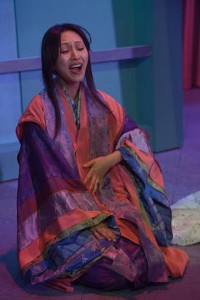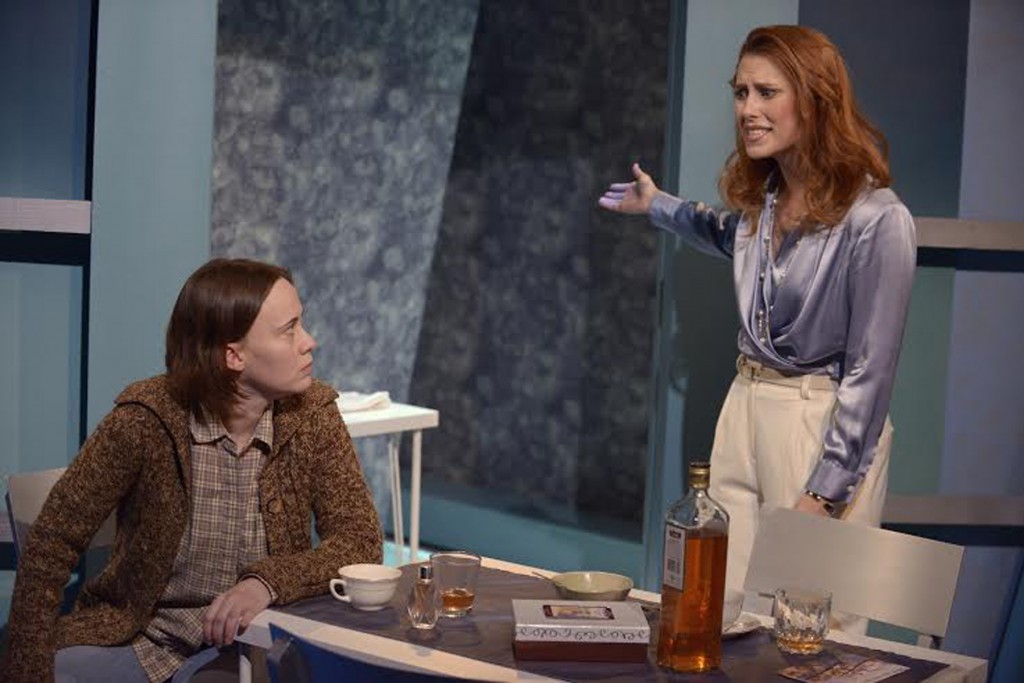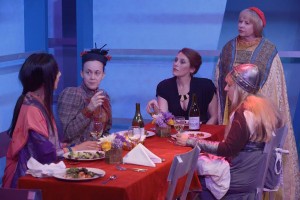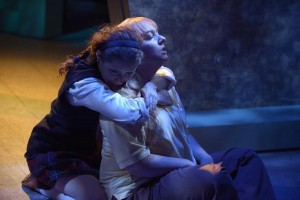YOU’RE THE TOP, GIRLS
For the most part, Joyce, a working class Englishwoman in Ipswich is not a sympathetic or likeable person: She is annoyed by her 16-year-old daughter Angie (who admittedly is belligerent and daft), and begrudging toward her sister, Marlene, whom she views as a ball-busting, career-driven, selfish, soulless abandoner (not that there isn’t some truth in that). Marlene escaped their dysfunctional home years ago and is now a newly promoted managing director at an employment agency named Top Girls. After years away from her estranged sister, Marlene makes an unexpected visit, but the sisters’ acrimonious relationship causes them to have a particularly pernicious argument, after which Marlene exits to speak with her niece in another room.
With the barely audible voices of her family in the background, Joyce is left to stare into space for an extensive amount of time. During this long pause, the pale-faced Karianne Flaathen, who plays Joyce in Antaeus Theatre’s superlative revival of English playwright Caryl Churchill’s 1982 feminist manifesto Top Girls, doesn’t go for self-pity or righteousness; she simply gazes with a careworn, faraway look, but we can see the millennia of female strife in her eyes. This quiet, naked moment not only articulates Churchill’s themes’”a woman’s precarious balance between work and personal life and getting ahead, surviving, and finding fulfillment in a male-dominated world’”but it is one of the most heartbreaking and transcendent moments you may ever see in the theater.
 The mélange of magical moments that swirls throughout the production is courtesy of director Cameron Watson, a man. I mention this because as political correctness clings tenaciously to the art world, it is refreshing that Antaeus Company saw fit to place a man at the helm of a feminist play with an all-female cast; they knew he was the man for the job. It’s always a tough assignment for any director of an Antaeus production: Many of their talented ensemble get professional jobs at the last minute so double-casting is a necessity (I saw the “High Flyers” cast, which alternates with the “Ballbreakers” cast; a computer-generated “mash up” of the two casts occurs at select performances). Between “partner casting” and odd directing choices, many of their productions have been missing the mark, but Top Girls is one of their best. Watson brings nuance, beats, and back story to each of the many characters (seven women play 16 roles). I have seen six of the seven actresses before and this is their most superlative work. As Marlene, Sally Hughes is a welcome addition to Antaeus, offering an affecting blend of power and melancholy.
The mélange of magical moments that swirls throughout the production is courtesy of director Cameron Watson, a man. I mention this because as political correctness clings tenaciously to the art world, it is refreshing that Antaeus Company saw fit to place a man at the helm of a feminist play with an all-female cast; they knew he was the man for the job. It’s always a tough assignment for any director of an Antaeus production: Many of their talented ensemble get professional jobs at the last minute so double-casting is a necessity (I saw the “High Flyers” cast, which alternates with the “Ballbreakers” cast; a computer-generated “mash up” of the two casts occurs at select performances). Between “partner casting” and odd directing choices, many of their productions have been missing the mark, but Top Girls is one of their best. Watson brings nuance, beats, and back story to each of the many characters (seven women play 16 roles). I have seen six of the seven actresses before and this is their most superlative work. As Marlene, Sally Hughes is a welcome addition to Antaeus, offering an affecting blend of power and melancholy.
Yet be aware before you go that Churchill writes with a non-linear structure. In her plays, themes of gender identity, feminist politics, and class struggle have straightforward scenes interspersed with dreamlike incidents which at first glance seem to have nothing to do with the story. Top Girls begins with a surrealist scene at a modern restaurant in which Marlene impossibly brings together famous women from history to celebrate her promotion by drinking and trading war stories. Soon we are in the temp office and then Joyce’s home.
Don’t bolt at intermission if you don’t understand this vacillation between Naturalism and Surrealism. For the better part of her long and distinguished career, Churchill (Far Away, Cloud Nine) has veered from realism the better to explore her trademark themes while bringing attention to barbarism and the abuse of power. I’m not sold, as some are, that she is Britain’s greatest living playwright–sometimes she’s so abstruse that I get a headache trying to put the pieces together. For the uninitiated, I can assert that Top Girls is one of her most accessible works. Let Antaeus and Watson and that amazing puzzle-piece set by Stephen Gifford put the pieces together for you.
photos by Daniel G Lam
Top Girls
Antaeus Company
5112 Lankershim Blvd in North Hollywood
Thurs & Fri at 8 ; Sat & Sun at 2 and 8
ends on May 18, 2014
for tickets ($30-34), call 818.506.1983 or visit Antaeus





{ 1 comment… read it below or add one }
I had to see this amazing production again to understand how the first scene related to the rest of the play. Marlene sits at the head of the table. The famous women at the party both represent the history of women’s oppression in a man’s world and different aspects of her psyche. All the women at the dinner had to sacrifice their children and motherhood to “succeed†and all were tormented by their “decision†to do so. Each of the women also reflect the fears and aspirations of Marlene. The consequences of this “leaning in†have been delayed and damaged daughters who will perpetuate this patriarchy. Frightening.